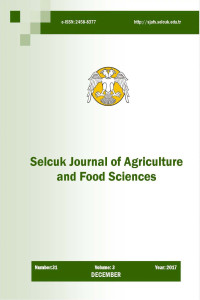Effects of Some Medicinal Plants Extract on Tetranychus cinnabarinus (Boisd.) (Acari: Tetranychidae) Nymph and Adult
Abstract
Tetranychus cinnabarinus (Boisd.) is one of the most important, highly polyphagous pests of a wide range of field and greenhouse crops throughout the world. In this study, ethanol extracts of four plants; Acorus calamus (root), Zingiber officinale (root), Foeniculum vulgare (seed) and Laurus nobilis (leaf) were tested on nymph and adult of the Tetranychus cinnabarinus (Boisd.) (Acari: Tetranychidae). Experiments were performed using 3 cm diameter leaf disks of bean dipped in plant extracts. Plant extracts were used in five different concentrations (20%, 10%, 5%, 2.5%, 1.25% w/w). It was tested three different exposure times, including 24, 48 and 72 hours. The experiments were carried out at 28 ± 1 ̊C temperature, 16 h L time period and 65 ± 5% relative humidity. As a result of the investigation, 20% concentration of all plants extract showed the highest mortality rates in nymph and adult stages. Residual effects of A. calamus and L. nobilis extracts to T. cinnabarinus nymphs were higher in 24, 48, 72 hour exposure times. 72 hour exposure time and at 5% concentration A. calamus and L. nobilis extracts were found toxic against T. cinnabarinus with 97% and 95% dead rates respectively. L. nobilis showed high toxic effect to T.cinnabarinus adults with 83%, 33% and 10% dead rates respectively in 5%, 2.5% and 1.25% concentrations and 72 hour exporsure time. The plant which had the lowest LC50 value in adults and nymphs at 72 hours exporsure time was Laurus nobilis (%.3.64, %1.37).
Bazı Tıbbi Bitki Ekstraktlarının Tetranychus cinnabarinus (Boisd.) (Acari: Tetranychidae)’un Nimf ve Erginlerine Etkile
Abstract
Tetranychus cinnabarinus Boisd. dünya üzerinde tarla ve sera bitkilerinde yüksek oranda zarara sebep olan önemli polifag zararlılardan biridir. Yapılan bu çalışmada, etanol çözücüsüyle hazırlanan eğir (Acorus calamus) (kök), zencefil (Zingiber officinale) (kök), rezene (Foeniculum vulgare) (tohum) ve defne (Laurus nobilis) (yaprak) olmak üzere dört bitki ekstraktının Tetranychus cinnabarinus (Boisd.) (Acari:Tetranychidae) ergin ve nimf dönemlerine rezidüel etkileri araştırılmıştır. Deneylerde fasulye bitkilerinin 3 cm çapındaki yaprak diskleri ektraktlara daldırılarak kullanılmıştır. Ekstraktların %20, %10, %5, %2.5, %1.25 (w/w) olmak üzere beş farklı konsantrasyonu kullanılmıştır. 24, 48 ve 72 saat olmak üzere üç farklı maruz bırakma süresi denenmiştir. Denemeler 28±1 ̊C sıcaklık, 16 saat aydınlanma süresi ve % 65±5 orantılı nem koşullarında yürütülmüştür. Sonuç olarak, nimf ve ergin dönemlerinde en yüksek ölüm oranı ekstraktların %20’lik konsantrasyonunda belirlenmiştir. Araştırma sonucunda, T.cinnabarinus nimfleri üzerine eğir (A. calamus) ve defne (L. nobilis) ekstraktları tüm maruz bırakma sürelerinde daha yüksek toksik etki göstermiştir. 72 saatlik uygulama süresi sonunda %5’lik konsantrasyonda eğir %97, defne %95 oranında toksik bulunmuştur. Tetranychus cinnabarinus erginlerinde ise defne ekstraktı 72 saatlik uygulama süresi sonunda %5, %2.5 ve %1.25’lik konsantrasyonlarında sırasıyla %83, %33 ve %10’luk etki göstermiştir. 72 saatlik uygulama süresi sonunda ergin ve nimflerde LC50 değerinin en düşük olduğu bitki defnedir (%.3.64 ve %1.37).
Details
| Primary Language | English |
|---|---|
| Subjects | Botany |
| Journal Section | Research Article |
| Authors | |
| Publication Date | December 29, 2017 |
| Submission Date | April 15, 2017 |
| Published in Issue | Year 2017 Volume: 31 Issue: 3 |
Cite
Selcuk Agricultural and Food Sciences is licensed under a Creative Commons Attribution-NonCommercial 4.0 International License (CC BY NC).

